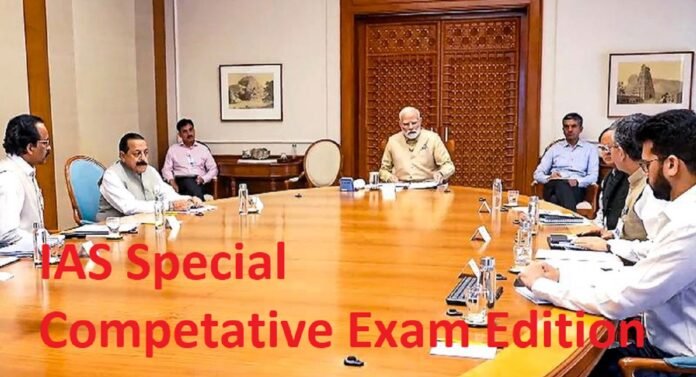Why is the discussion?
Recently, the Prime Minister of India laid out a visionary roadmap for the Indian Space Research Organization (ISRO) during a review meeting of the upcoming Gaganyaan mission, India’s first manned mission to space.
Table of Contents
Key aspects of the roadmap for ISRO:
- One of the central objectives is to establish an India-built, indigenous space station, to be known as the “Indian Space Station”. It will serve as a major asset in India’s space infrastructure.
- This important effort is expected to be realized by the year 2035.

Note: The International Space Station, which is currently managed by the US, Russia, Canada, Japan, and European space agencies, is projected to shut down by the year 2030.
- Landing an Indian astronaut on the Moon by the year 2040. It has been claimed by ISRO that this lunar mission will be a historic achievement for the country.
- To realize this vision, the ISRO Department of Space will develop a roadmap for lunar exploration which will include the Chandrayaan mission, the development of the Next Generation Launch Vehicle (NGLV), the construction of a new launch pad in India, the establishment of human-centric laboratories and related new technologies.
- The Prime Minister has urged Indian scientists to further expand their horizons by working on interplanetary missions in the ISRO.
- These include the development of a spacecraft to orbit Venus and another spacecraft to land on Mars, indicating a broad commitment to Solar System exploration.
Potential benefits of India’s increased involvement in space activities in the ISRO:
- Economic Benefits: India’s space capabilities catalyze technological progress with inter-industry applications, generating revenue and employment through commercial satellite launch services, resulting in substantial economic benefits.
- Geopolitical benefits: India’s space capabilities can act as a diplomatic tool in resolving international disputes peacefully.
- It could also provide India with geopolitical leverage in international negotiations, enabling the country to negotiate more favorable terms in trade, climate agreements, and global agreements.
- Improved disaster management: India can significantly improve disaster management by using space assets to monitor and respond to disasters.
- These satellites can help in forecasting natural disasters like earthquakes, tsunamis, and floods, thereby helping in timely evacuation and resource allocation.
- Agricultural Revolution: The possibility of an agricultural revolution increases with the help of space-based technologies, including satellite imagery and weather forecasting.
- Farmers can get accurate data on soil conditions, weather patterns, and crop health, helping them optimize farming practices and increase yields.
- Affordable space tourism: India may be able to offer affordable space travel due to its cost-effective space capabilities. Developments in space technology may result in sub-orbital and orbital space tourism becoming more accessible to Indian citizens and foreign tourists, resulting in huge financial benefits to the nation.
India’s obstacles related to space travel by ISRO:
- Technical Challenges:
- Despite significant progress made by the private sector in India’s space sector, developing cutting-edge technology for the demands of space missions still remains a major challenge, requiring substantial investment.
- Financial Constraints:
- Financial challenges are faced in balancing the costs of space exploration with other national priorities such as health care and education.
- Additionally, maintaining sustained investment in space initiatives requires intensive planning and support from the government.
- International Cooperation vs. Competition:
- India faces competition from capable space powers such as the United States, Russia, and China, which have made significant progress in space exploration.
- It is necessary to maintain a balance between cooperation with international space agencies and competition on the global stage.
The way forward
- Skills Development: Investing in space-related skills development programs can create a workforce with the knowledge and expertise needed for new space projects.
- Infrastructure development: Upgradation of space launch facilities and research centers ensures that India has the necessary infrastructure for more ambitious space missions.
The Virtual Launch Control Center (VLCC) established at Vikram Sarabhai Space Center is a good step in this direction.
- Space Security: It is important to ensure robust cyber security measures to protect space assets against potential cyber-attacks and data breaches.
- Government-Industry Collaboration: Government organizations and private businesses can work together to harness each other’s strengths to promote space exploration and technology.
- Promoting Indigenous technologies: Encouraging the development of Indigenous technologies ensures self-reliance and reduces dependence on external sources for space hardware.
NavIC or Indian Regional Navigation Satellite System (IRNSS) and NETRA project are important in this direction.
Read More
- RTI MIS 2023: Three lakh cases due with Information Commissions is a concern
- 9 billion kg e-waste goes unrecognized every year globally: A Global Threat
- The Gaza Strip- Why known as the world’s biggest “Open Air Prison”? Israel-Hamas conflict 2023
- World Economic Outlook 2023: IMF raises India’s GDP growth forecast to 6.3% from 6.1% for FY24








[…] ISRO to land a man on the Moon by 2040: Prime Minister Committed […]
[…] ISRO to land a man on the Moon by 2040: Prime Minister Committed […]